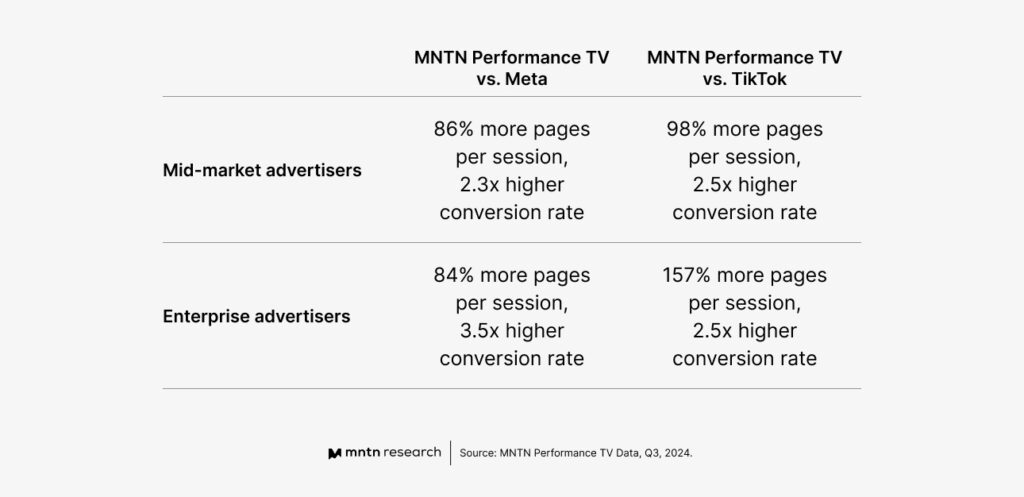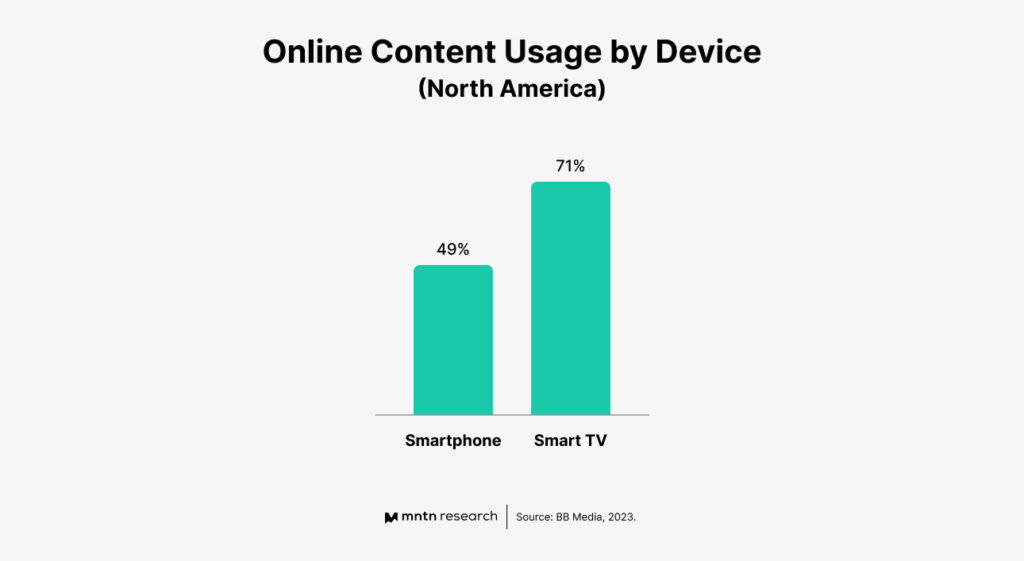Analysis
How Connected TV Advertising Amplifies the Audience Experience
by Melissa Yap3 min read
Abstract
- Connected TV ads provide a more engaging viewing and advertising experience. MNTN proprietary first-party data in Q3, 2024 reveals that performance campaigns on CTV drive more engaged site traffic than paid social media ads.
- Smart TVs continue to be the preferred way of consuming content online, with 71% of viewers in North America consuming content via smart TVs, versus 49% on smartphones.
- An analysis of leading streaming network Netflix revealed that 60% of viewers mostly view content on TV during peak hours (8-10 p.m.), while switching between mobile and tablet during other times of the day.
You’ve likely read about Connected TV’s high average completion rate and how it complements second-screen viewing behavior. But what about its effect on web traffic and user engagement? If you’re an avid MNTN Research reader, then you’re already well acquainted with the performance benefits of Connected TV (supported with first-party data from our Performance TV platform). If you’re dipping your toes into the world of Connected TV, then let’s get to know CTV’s halo effect a bit better, because performance campaigns on Connected TV do more than generate ROI — they offer a unique, net-new addition to your performance marketing mix.
May the Odds Engagement Metrics Ever Be in Your Connected TV’s Favor
TV’s ideal viewing format not only brings opportunities for brands to shine on a creative level, but it also generates a level of engagement unmatched by other performance channels. Based on an analysis of hundreds of mid-market and enterprise advertisers who were both active for at least 30 days on MNTN Performance TV, Meta, and TikTok in Q3, 2024, CTV commercials generated more engaged site traffic than paid social media ads.
The table below illustrates the performance lift when visiting an advertiser’s website after viewing a MNTN ad, versus on Meta or TikTok. A minimum threshold of 1,000 sessions for either MNTN or the compared social media network must have been met in order to be included in the dataset.

CTV Provides a More Accessible Environment for Viewers To Take Action
A recent study by global data science company, BB Media, revealed that smart TVs continue to surpass mobile phones as the preferred device when consuming online content.

But how did this fare throughout the day? Technology and media insights company Digital i observed viewing patterns on top streaming platform Netflix, and revealed that on average, 60% of the network’s viewership was consumed via OTT devices like CTV, and usually between peak viewing times between 8 to 10pm in the evening. This changes in the early hours of the morning, where only around 40% of all Netflix viewing occurs on a TV, while 30% is viewed via smartphone. However, throughout the day, viewership was split across TV, smartphone, and tablet, for example an early-morning pick-up in Netflix viewing via tablets, followed by a dip in smartphone viewing and a rise in TV viewing during peak hours.
So, not only are TVs the device of choice for consuming content online, but they’re also a viewer’s go-to during peak viewing times. As an advertiser or brand, this is an ideal scenario when trying to get in front of potential customers (or returning ones), especially coupled with CTV’s audience-first capabilities that seeks out your in-market audiences, no matter what they are watching.
The Living Room is the New Shopfront
There is a place for all performance marketing channels to exist — after all, they don’t call it the marketing mix for nothing. Even though both Connected TV and paid social benefit from advanced audience targeting and campaign performance optimization, CTV’s unique ad environment draws in a more engaged consumer who is likely to take action — even when they’re in the living room when watching one of their favorite shows from 8 to 10pm.
Subscribe to the MNTN Research Weekly
Sign up to receive a weekly feed of curated research, sent straight to your inbox.
Resources